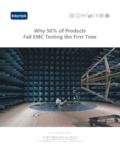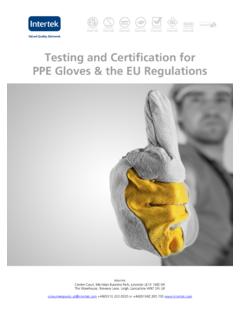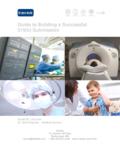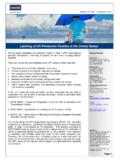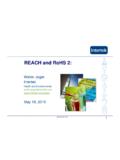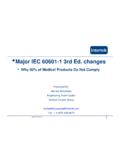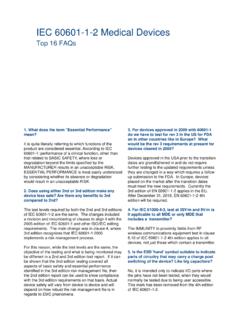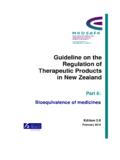Transcription of Closing the Gap - Intertek
1 For more information about Intertek s Testing and Certification capabilities, please contact Intertek at 1-800-WORLDLAB, email or visit our website at Closing the Gap Understanding the Software 510(k) Review Process Closing the Gap: Understanding the Software 510(k) Review Process 1 Introduction The creation of quality medical software is a challenge to the medical device industry. Getting a medical device cleared through the FDA premarket 510(k) approval process can be just as challenging, especially if it has software included. The role of software in medical devices has evolved to encompass more and more functionality.
2 Devices that were previously seen as quite rudimentary are now including software for more critical functionality. The medical device industry is slowly moving toward higher levels of features, networking, data gathering, imaging, and diagnostic functions. The complexity is growing from the most complex radiological devices all the way down to the infrared heat lamp. Software, of varying levels of complexity, can be found in all of them. The question on the minds of many medical device manufacturers is: How can we best ready ourselves for the premarket approval process? The answers have been provided by the FDA through the following guidance documents: Guidance for the Content of Premarket Submissions for Software Contained in Medical Devices General Principles of Software Validation; Final Guidance for Industry and FDA Staff Guidance for Industry, FDA Reviewers and Compliance on Off-The-Shelf Software Use in Medical Devices These guidance documents are the number one resource for all 510(k) submitters as they have each been FDA-created and approved.
3 They contain guidance that will be used when reviewing your software documentation, so it is in your best interest to follow them as closely as possible and be prepared to provide the information they are requesting whenever possible. The First Step Understanding The first step in preparing 510(k) software documentation is to understand the mindset behind the FDA guidance documentation and the mindset of a potential reviewer. We can t predict how a reviewer will think, but we can understand the basic structure within which they are reviewing, and that is one of the primary aims of this document. What is software as it relates to a medical device and as it relates to a 510(k) review?
4 Software, other than the most rudimentary, is much more than just another component of a device that makes it work. Inside the software component box, you will see that the parts while not physically moving or electrical are all interconnected. If one of these Closing the Gap: Understanding the Software 510(k) Review Process 2conceptual, documental, procedural parts malfunctions there could be costly and dangerous outcomes. The outputs and inputs are interconnected through the complex interoperation of the software. If you take timelines out of the software lifecycle you can see the process connected within itself and outward to the device manufacturing staff and engineers, and the software and hardware development environment used to create this software.
5 It s this drilling down that will put the width and breadth of what is being reviewed into perspective. The creator of a 510(k) that includes software especially software that is a Major Level of Concern should not view the software as a part of a machine, but rather as an entirely separate entity. The software is connected to this medical device by more than just inputs, functions, sub-routines, objects, classes, and outputs. It is the sum of the parts that work towards its creation from initial device description to hazard analysis and through all requirements, the architectural layout, design specifications, verification and validation, revisions, and death.
6 The software review for 510(k) devices is the review of each of these parts, including how they come together and form a quality component that fits and works correctly in the design of the medical device. Essentially, the software review is actually a review within a review, and that s the best way to approach it from both a reviewer and manufacturers perspective. That is not to say that some medical device software isn t going to be little more than some basic assembly code that takes input, goes through a simple decision tree, and dumps out an output to a piece of hardware. This type of software may appear basic, but it is still as good as what goes into it.
7 This applies to 510(k) software documentation as well. The submittal will only be as good as what is put into it and this is what a reviewer must contend with. The Least Burdensome Approach Why it s Important You may have heard of the Least Burdensome Approach but what is it really? The word burden is generally ambiguous and subjective. Luckily, the FDA offers a definition of burden as it relates to the least burdensome approach to reviewing premarket submissions. Here it is: A successful means of addressing a premarket issue that involves the most appropriate investment of time, effort, and resources on the part of industry and FDA.
8 The Least Burdensome Approach is part of the FDA Modernization Act of 1997. Basically, this act was an attempt to streamline what had become a burdened system of review. It Closing the Gap: Understanding the Software 510(k) Review Process 3was burdened in the way that it caused delays in getting new medical devices to market. Lead times were long and the system heavily favored big business that had the funds and resources to get their products through the FDA system. This was a poor situation for small business, doctors and patients, all of whom felt the effects of delays in new medical device technology reaching the market.
9 Although the FDA took it upon themselves to reduce what manufacturers saw as unnecessary (burdensome) requirements those that greatly increased a medical device s time to market they failed to reduce statutory requirements for proving that a new device is substantially equivalent to a previously marketed device. Therefore, the FDA Modernization act was born and the Least Burdensome Approach was brought forth. Several years later the FDA created a guidance document for the approach: The Least Burdensome Provisions of the FDA Modernization Act of 1997: Concept and Principles; Final Guidance for FDA and Industry The review process for 510(k)s is underpinned by the Least Burdensome Approach.
10 It is important to understand this approach and to look at it objectively, remembering that the requirements for proving substantial equivalence have not and will not change. A submitter of a 510(k) still must show that their device is as safe and effective as a previously cleared predicate. The methods for demonstrating substantial equivalence are the primary avenues for lessening the burden on manufacturers. To review, let s start with what the FDA states within the document mentioned above. The FDA says: FDA and industry should focus on those issues that can affect the substantial equivalence (SE) determination, which describes whether or not the device has the same intended use as the predicate device and is as safe and effective as a legally marketed device.
